The Al Ward Building: Architecture and Investment Insights
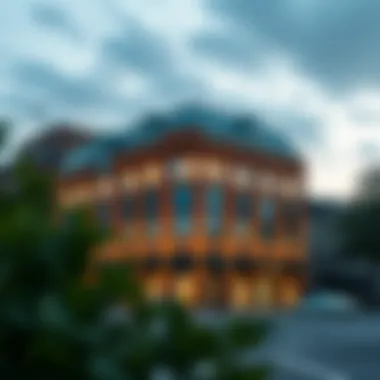
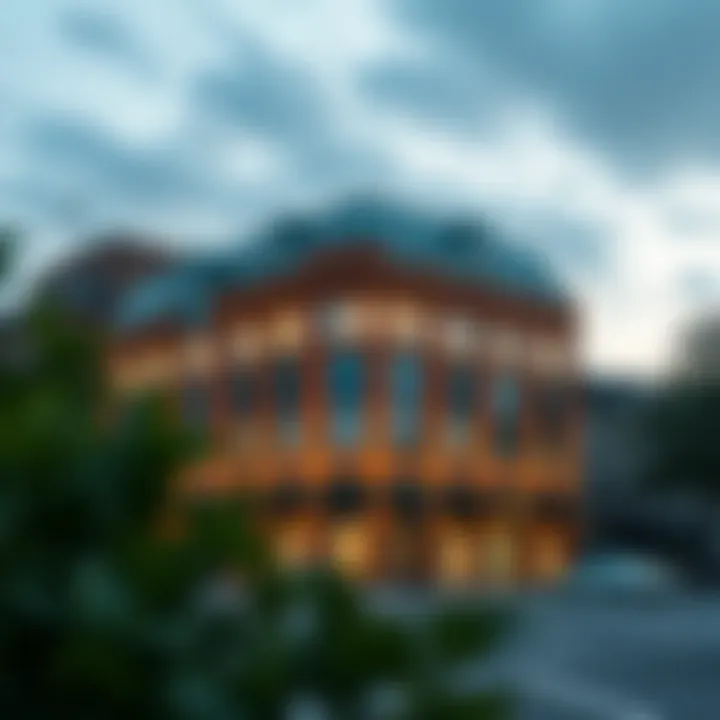
Intro
Nestled in the heart of Dubai, the Al Ward Building stands as a testament to innovative design and strategic real estate investment. Combining a striking façade with an advantageous location, this iconic structure has quickly garnered attention from homebuyers, investors, and real estate professionals alike. Dubai's dynamic market, characterized by its rapid evolution and substantial foreign investment, makes the Al Ward Building a focal point for those considering a stake in the region's property sector. In this article, we aim to peel back the layers surrounding the building, examining its architectural merit, locational benefits, and the savvy investment opportunities it presents amid the ongoing surge in Dubai's real estate landscape.
Market Trends
Current Real Estate Landscape
The pulse of the Dubai real estate market is vibrant and ever-changing. As of late 2023, a noticeable upswing in property demand is evident, driven largely by expatriates and foreign investors seeking both residential and commercial spaces. Factors such as a growing economy, tax-free propositions, and a stable currency continue to attract a diverse pool of buyers. Moreover, with government initiatives encouraging foreign ownership, the city is witnessing a thriving property development scene.
For any investor or potential homebuyer eyeing the Al Ward Building, it’s crucial to understand the market dynamics at play:
- Population Growth: Dubai’s population has seen a continuous growth trajectory, leading to increased demand for housing and commercial spaces.
- Tourism Boom: A continuous influx of tourists enhances the attractiveness of real estate investments, particularly in well-located properties like the Al Ward Building.
- Infrastructure Development: Ongoing upgrades in transport and amenities surrounding the building add significant value, making it a coveted location.
Future Predictions and Insights
Looking ahead, the prognosis for the Dubai real estate sector suggests sustained growth, fueled by infrastructure improvements and an uptick in international visitors. Analysts predict that luxury properties will retain their allure, driven by Dubai's status as a global hub. The Al Ward Building, with its unique position and architectural flair, is poised to experience an appreciation in value.
Experts point to several key trends:
- Sustainability: Increasingly, buyers are placing importance on eco-friendly building designs. The architectural decisions made in the Al Ward Building could reflect this shift.
- Technological Integration: Properties that incorporate smart technology are likely to attract a premium from tech-savvy investors.
- Remote Work Trends: As remote working gains traction, demand for residential properties that offer workspace amenities will continue to rise.
"Investors must recognize that the landscape of real estate is ever-evolving. Staying ahead of trends can lead to lucrative opportunities."
Investment Strategies
Investing in a property like the Al Ward Building can be more than just a financial decision. It’s about grasping the nuances of the market while identifying personal or business goals. Here are some strategies to consider:
Smart Property Investments
- Understanding Market Cycles: Investors should familiarize themselves with the cyclical nature of real estate markets. Timing can be everything when it comes to buying.
- Researching the Building’s Value: Before committing, one should conduct a thorough analysis of the Al Ward Building’s value trends, comparative property analysis, and rental yields in the area.
- Networking: Engaging with real estate agents who specialize in the Dubai market can provide insider knowledge and lead to off-market opportunities.
Financing Options for Investors
Navigating financing can be daunting, but understanding the available options is crucial.
- Bank Loans: Traditional bank mortgages are common, but be aware of the terms and conditions, especially for foreign buyers.
- Crowdfunding Investments: An emerging avenue, crowdfunding offers a way to pool resources with others to invest in larger properties.
- Equity Partnerships: Partnering with other investors can spread the risk and enhance purchasing power, allowing for more substantial investments in properties like the Al Ward Building.
With the right strategies, the potential for returns on an investment at the Al Ward Building is substantial. As the landscape changes and evolves, staying informed will be your best bet.
For more detailed insights on Dubai’s real estate trends, check out resources at Encyclopedia Britannica and the UAE government’s real estate guidelines.
Prologue to the Al Ward Building
The Al Ward Building stands as a pivotal structure within Dubai’s ever-evolving urban landscape. It is not merely a collection of walls and windows; it embodies the essence of modern architecture harmonizing with the rich cultural tapestry of the region. This article seeks to unravel the many layers that make the Al Ward Building a compelling subject for both investors and homebuyers alike.
Understanding the Al Ward Building requires a look beyond its exterior. It is crucial to appreciate how its architectural design complements the functionality required by contemporary occupants. Potential investors might find themselves drawn not just to the aesthetics, but also to the strategic planning behind its creation. For homebuyers, the physical structure becomes a living space, a place of comfort, and a community hub.
The importance of location cannot be overstated. Nestled in a prime area, the Al Ward Building provides accessibility to key urban amenities. It represents the intersection of lifestyle and investment, offering seamless connections to educational institutions, shopping districts, and recreational facilities. This makes it an attractive option for expatriates who seek both convenience and community in their new environment.
As we peel back the layers of this architectural gem, we realize that investing in the Al Ward Building goes beyond financial considerations. It is about being part of a thriving metropolis that is continuously shaping its future. The building exemplifies what modern living in Dubai means, marrying form and function while respecting local heritage. Thus, the investment prospects are bolstered by speculative growth in surrounding real estate markets and cultural appreciation for quality architecture.
In the following sections, we will explore various aspects of the Al Ward Building, including its architectural intricacies, surrounding location, real estate trends, and investment opportunities. Through this comprehensive lens, we will gain insight into why the Al Ward Building is increasingly becoming a focal point for discerning investors and homeowners.
"In every corner of the Al Ward Building, one can sense the pulse of Dubai - a city where the past and the future merge into vibrant present."
Through careful analysis, we endeavor to present a holistic view of this landmark, empowering potential buyers and investors to make informed decisions.
Architectural Overview
The architectural overview of the Al Ward Building is crucial not only to understanding its visual impact but also its integration into the urban fabric of Dubai. Architecture is more than just structures; it encapsulates culture, innovation, and the future of living spaces. The Al Ward Building stands as a testament to contemporary design that respects tradition while embracing modernization. This section will explore the elements that make the Al Ward Building remarkable, focusing on its design philosophy, material choices, and notable innovative features.
Design Philosophy
The design philosophy of the Al Ward Building is a balancing act between form and function. Here lies a deliberate choice that pays homage to Dubai’s rich heritage while also projecting into the future. The architects behind this project crafted a blueprint that speaks to sustainable living, aesthetics, and practicality. In a city that is constantly evolving, the building reflects aspirations of its inhabitants—an emblem of sophistication that does not shy away from the environment.
The layout maximizes natural light and ventilation, aiming to create a welcoming atmosphere. Each floor seems to flow into the other, fostering community while allowing privacy. The choice of open spaces encourages interaction among residents, thereby enriching the overall living experience.
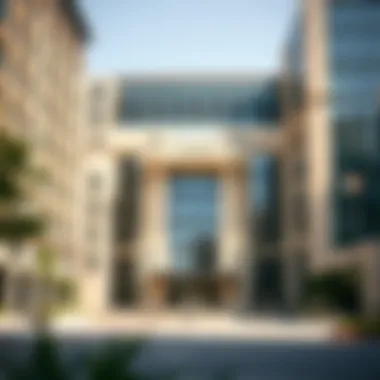
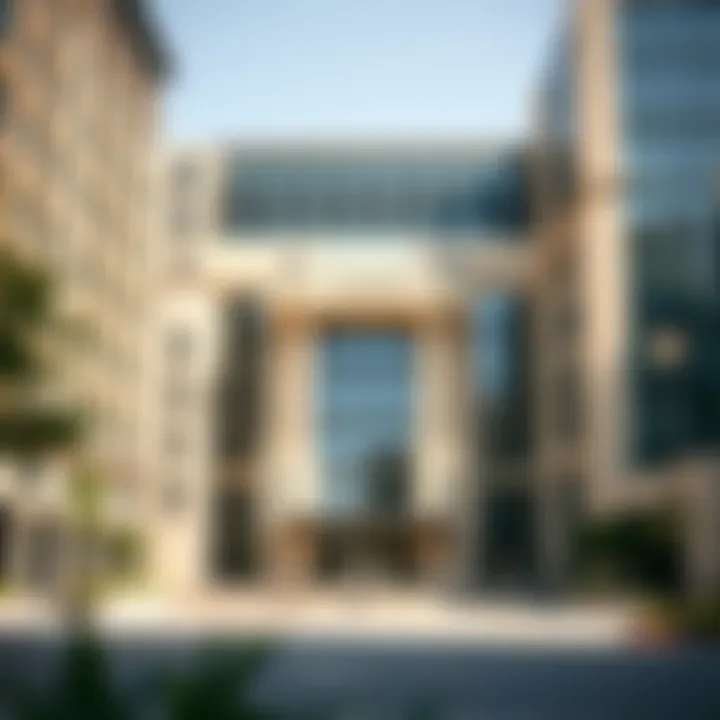
"Good architecture contributes to the identity of a place; the Al Ward Building is both a landmark and a home."
This sentiment underlines how the building serves its residents while solidifying its presence within the neighborhood.
Material Selection and Sustainability
In today’s world, where environmental concerns are critical, the Al Ward Building has taken material selection seriously. The developers have made conscious choices, opting for sustainable materials that not only reduce carbon footprints but also enhance energy efficiency. For instance, the use of recycled aluminum for facades not only provides durability but also a modern edge to the exterior.
The innovative use of low-e glass allows natural light to flood into interiors while cutting down energy costs associated with air conditioning. This feature is particularly significant in Dubai, where temperatures can soar. Furthermore, rainwater harvesting systems have been incorporated, contributing positively to the overall sustainability goals of the project.
By prioritizing eco-friendly options, the Al Ward Building sets an example for future developments, proving that luxury and responsibility can coexist.
Innovative Features
When discussing the Al Ward Building, it’s impossible to overlook its suite of innovative features designed to enhance both comfort and convenience. One notable aspect is the smart home technology embedded into the living spaces. This development allows residents to control lighting, temperature, and security via their smartphones. By meldong technology with daily living, it caters to a modern lifestyle where convenience is paramount.
Security is another aspect where innovation shines. Advanced surveillance systems coupled with secure access points assure residents of their safety in this urban landscape. Beyond the usual amenities, the building boasts communal gardens and rooftop terraces that not only provide scenic views of the city but also space for relaxation and social gatherings.
Overall, the Al Ward Building doesn’t just aim to fulfill basic living requirements but elevates the concept of modern living to new heights.
Location Analysis
Understanding the location of the Al Ward Building is crucial for anyone considering investment or residence in Dubai. This section delves into the key aspects that make this location not just a site on the map, but a vibrant nexus for lifestyle and investment. From its proximity to central hubs to the ease of access and the surrounding neighborhood dynamics, every detail plays a role in enhancing the Al Ward Building's value.
Proximity to Key Areas
One of the most appealing factors about the Al Ward Building is its ideal location within the bustling city of Dubai. Nestled close to major commercial centers, it offers residents and investors the convenience of urban living without sacrificing comfort. Here are a few notable points regarding its proximity:
- Commercial Districts: The Al Ward Building sits in close range to key business hubs such as the Dubai International Financial Centre (DIFC) and Downtown Dubai. This not only boosts the attractiveness for business professionals but also ensures that daily commutes are a breeze.
- Cultural Landmarks: Being near attractions like the Burj Khalifa and Dubai Mall allows residents to take advantage of cultural experiences. With shopping, dining, and leisure options around, there's always something to do just a stone's throw away.
- Educational Institutions: Families considering the building will appreciate its proximity to several reputable schools and universities, which enhances the appeal for long-term residents.
This strategic positioning enhances the desirability of the Al Ward Building, making it a prime candidate for residential and commercial investments alike.
Accessibility and Transportation
A good location is often characterized by its accessibility, and the Al Ward Building certainly checks this box. The transportation infrastructure around the building is meticulously designed to support an active urban environment:
- Public Transport Access: The building is closely located to several metro stations, which means residents can conveniently travel across the city without the hassle of traffic. This is crucial for anyone who dreads the daily grind of heavy traffic.
- Road Connectivity: Major roads and highways surrounding the area ensure swift access to the Dubai International Airport. This is particularly advantageous for expatriates and frequent travelers.
- Cycling and Pedestrian Pathways: The urban developer has integrated cycling paths and pedestrian-friendly walkways, promoting a healthy lifestyle. Whether one prefers to stroll or cycle, getting around is easy and enjoyable.
Such robust transportation options not only cushion daily life but also enhance the overall value of the property, appealing to both commuters and those who appreciate convenience.
Neighborhood Characteristics
The neighborhood surrounding the Al Ward Building adds another layer of value to this investment. Understanding what the community offers can greatly influence a buyer's decision:
- Vibrant Community Life: The immediate area is known for its cosmopolitan feel, bringing together residents from all walks of life. This diversity enriches community engagements and social interactions.
- Safety and Security: The neighborhood prioritizes safety, with well-lit streets and regular patrols. This can be a deciding factor for families looking for a secure living environment.
- Green Spaces: Parks and recreational areas nearby foster a sense of community. Here, families can enjoy weekend picnics or fitness enthusiasts can exercise in open spaces, which contributes to a balanced lifestyle.
In summary, the attributes of the Al Ward Building's location—its proximity to key areas, accessibility through transportation, and vibrant neighborhood characteristics—paint a picture of a highly desirable living and investment opportunity in the heart of Dubai.
"Location is everything, and the Al Ward Building truly exemplifies the importance of choosing the right spot in a flourishing city like Dubai."
For further details about the dynamic nature of Dubai's real estate market, consider visiting Wikipedia or Britannica.
Real Estate Market Trends in Dubai
Understanding the real estate market trends in Dubai is essential for homebuyers, investors, and developers who are considering the Al Ward Building as part of their portfolio. With the city's landscape continuously evolving, keeping abreast of market dynamics enables stakeholders to make informed decisions. Factors such as economic conditions, demographic changes, and infrastructural developments play crucial roles in shaping the market dynamics. The knowledge of these trends not only highlights the current state of the market but also provides insight into future opportunities and challenges within the Dubai real estate sector.
Current Market Dynamics
Dubai's real estate market has witnessed significant fluctuations in recent years, influenced by various domestic and global factors. As we delve into the current market dynamics, a few points stand out:
- Supply and Demand: The surge in demand for luxury properties is evident, especially in areas such as Dubai Marina and Jumeirah. However, with the ongoing constructions of new developments, there is an overload of available properties, which can lead to a temporary imbalance.
- Investment Hotspots: Areas like Downtown Dubai and Business Bay remain traditional favorites among investors. Yet, newer developments are emerging in areas such as Dubai South and the Dubai Creek Harbour, appealing to those seeking value for money while enjoying modern facilities.
- Rental Yields: Currently, rental yields for residential properties in Dubai range from 5% to 10%, depending on the location and type of property. The high yield potential continues to attract investors looking for profitable avenues in real estate.
- Foreign Direct Investment: The influx of expatriates and foreign investors bolsters the real estate market. In fact, current policies that relax property ownership laws for foreigners contribute significantly to the market’s growth.
Predictions for the Future
Looking toward the horizon of Dubai's real estate market, several trends and predictions emerge, which can shape decision-making in the coming years:
- Sustainable Development: As the world turns its focus toward environmental sustainability, future real estate developments in Dubai will likely prioritize eco-friendly solutions and green technologies. Properties that incorporate sustainable features may see increased demand.
- Technological Integration: The impact of technology on real estate cannot be overstated. Smart home technologies and digital platforms for property management are expected to revolutionize the living experience and operational efficiency.
- Economic Diversification: With the UAE's vision for economic diversification, a push towards non-oil sectors is anticipated. This could bring about new job opportunities and, in turn, stimulate demand for residential properties.
- Continued Growth in Expatriate Population: As Dubai remains an attractive destination for expatriates, the rise in population will fuel demand in the housing sector, particularly in areas like the Al Ward Building where proximity to amenities is a key selling point.
In summary, the real estate market in Dubai holds a wealth of potential, and understanding both current dynamics and future predictions will equip investors and homebuyers with the insights needed to make strategic decisions.
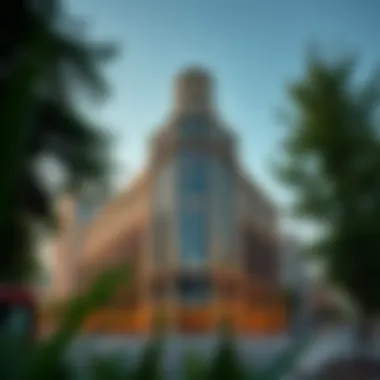
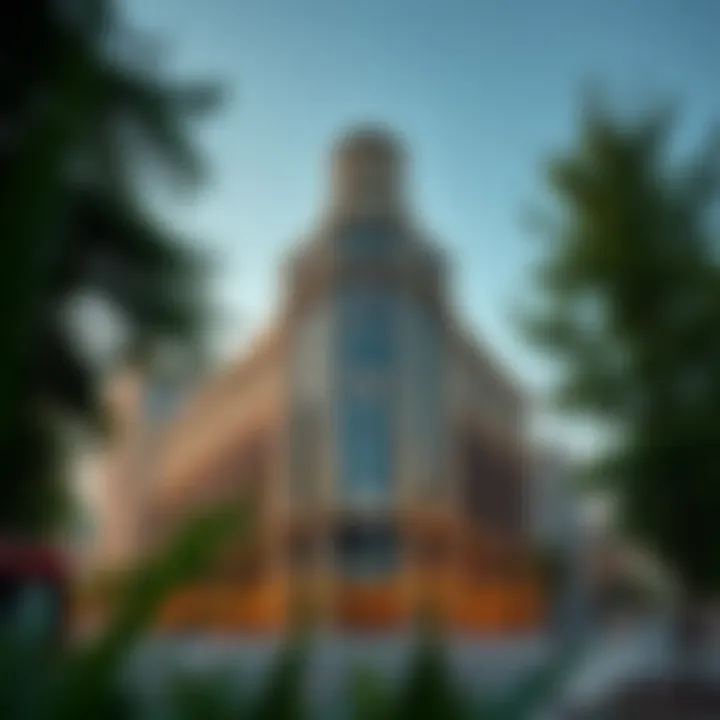
Comparative Analysis
When it comes to making informed decisions in real estate, a comparative analysis is crucial. This section focuses on the significance of evaluating the Al Ward Building against other developments. Understanding its unique qualities, benefits, and positioning within the market not only sharpens buyer insights but can also lead to more strategic investment decisions.
In the bustling property market of Dubai, buyers and investors are often faced with a myriad of choices. The Al Ward Building is just one option among many. Thus, evaluating it against similar developments allows potential stakeholders to discern its offerings from those of competition. This insight helps in determining where value lies, whether in design, amenities, price points, or future potential.
Additionally, a comparative analysis underscores how market trends can differ vastly between neighborhoods or property types. By examining key metrics such as:
- Price per square foot
- Historical appreciation rates
- Occupancy levels
- Amenities offered
- Community features
buyers can draw nuanced conclusions about investment prospects in the Al Ward Building versus other properties. This assessment sets a solid foundation for understanding market dynamics and strategic approaches for both short-term and long-term investment strategies.
Cabinetry may not be everyone's cup of tea, but often it's precisely those unnoticed features that can create an edge in decision-making.
Al Ward Building vs Other Developments
The Al Ward Building distinctly sets itself apart from its counterparts in the area. Its architecture and modern design are complemented by its strategic positioning. For example, while other developments may prioritize high-rise structures, the Al Ward Building blends seamlessly with its surroundings, promoting a sense of community that resonates with residents. Here are some points to consider when directly comparing:
- Architectural Style: The Al Ward Building utilizes contemporary designs, contrasting with older or more traditional structures found nearby.
- Environment: Its green spaces and communal areas provide an inviting atmosphere that can be markedly different from more commercial developments.
- Rental Yields: Properties in this category often report higher rental demand due to their desirable living conditions, compared to developments that may see fluctuations in tenant interest.
In terms of community feedback, reviews often highlight how the combination of modernity and convenience within the Al Ward Building leads to a higher satisfaction rate among residents. It's this kind of prospective insight that steers future buyers or investors towards smart choices. When looking at leasing opportunities for business or residential needs, contentment levels can greatly influence long-term occupancy.
Amenities Comparison
Amenities play a pivotal role in attracting potential buyers or renters. A thorough comparison reveals that the Al Ward Building boasts significant advantages. Developments in this area vary hugely in what they offer, which can heavily sway decision-making for prospective occupants.
Consider the following amenities typically featured in the Al Ward Building and how they stack up:
- Fitness Facilities: Residents enjoy exclusive access to state-of-the-art gyms, unlike other properties that may only provide basic fitness options.
- Outdoor Spaces: The Al Ward Building not only includes landscaped gardens but also walking paths that enhance well-being.
- Retail Options: An on-site convenience store can be a game changer, providing accessibility for everyday needs, which many other complexes lack.
In the end, the amenities must align with the lifestyles of the target demographic. As more discerning buyers seek lifestyles that promote wellness, community engagement, and convenience, the Al Ward Building shines bright against the backdrop of other developments.
The relationship between these features and individual preferences ultimately determines the desirability of the property, leading to holistic growth in the region and an enhanced investment landscape.
"In real estate, the location may matter, but the quality of life in a community is what truly sells a property."
Investment Opportunities
The exploration of investment opportunities in the Al Ward Building is not just about numbers and contracts; it’s about envisioning the potential that lies in this architectural gem. The importance of this section spirals from the rapid growth of Dubai’s real estate sector, which has seen rising demand both from within the region and internationally. Looking into the intricacies of investment in the Al Ward Building paints a picture not only of what is at stake today but of what could flourish tomorrow.
Potential investors should take note of key elements when assessing opportunities within this property. First up is the strategic positioning of the building. Located in a prime area, the Al Ward Building offers access to vital commercial and recreational districts, making it a favorable pick for both occupiers and investors. Being in proximity to businesses, schools, and entertainment hubs, there's an underlying pulse that drives demand, fueling price appreciation over time.
Additionally, Dubai's tax-friendly environment is a cherry on top. With no property tax and a relatively lower cost of living compared to other global hubs, investors can stretch their dollars further. The regulations seem to favor buyers, hence upping the ante for smart purchases.
"Investing in Dubai's real estate is not just owning property; it's about becoming part of a thriving community."
Potential Returns on Investment
When discussing prospective returns, it’s critical to consider not only the immediate financial gains but also the long-term benefits of holding a property in the Al Ward Building. Historically, Dubai's real estate market has delivered significant returns, with prime properties continuously appreciating due to robust demand. Investors could eye annual rental yields typically ranging from 7% to 10%, depending on market conditions and property management.
Investors should consider that the appeal of the Al Ward Building stems not only from its design but also from the growing expatriate community within the city. With expatriates driving rental demand, the potential for consistent rental income increases significantly. As more people flock to Dubai for career opportunities, the need for housing remains a dependable factor influencing returns.
- Historical Capital Appreciation: Look at property trends over the past decade; many areas in Dubai have consistently seen price increases.
- Rental Demand Anticipation: Consider the projected increases in the expatriate population and international businesses setting up shop.
- Economic Growth Impacts: With continuous investments in infrastructure and tourism, property values are likely to rise further.
Buyer’s Market Considerations
Entering the real estate market can be a double-edged sword. For buyers eyeing the Al Ward Building, understanding market indicators is crucial. Currently, the market is characterized as a buyer’s market, offering a variety of options at different price points, affording investors leverage in negotiations.
Investors must approach their decisions with some insights into market cycles. Properties that are newly built, like the Al Ward Building, may be set at competitive prices, presenting an opportunity to secure a piece of the pie before prices burgeon with rising demand.
Some considerations that buyers should be aware of include:
- Comparative Pricing: Evaluate prices of similar properties within the vicinity to negotiate effectively.
- Property Condition: Recognizing that newer properties promise fewer immediate renovation costs can be a tactical advantage.
- Future Development Plans: Understanding upcoming infrastructure or developments can help gauge future value.
Considering these aspects fosters a more knowledgeable approach, allowing potential buyers to navigate their investment journey with greater confidence.
Living at the Al Ward Building
Living at the Al Ward Building is a unique venture that seamlessly combines architectural elegance with functional aesthetics in one of the most notable locales of Dubai. The significance of this topic lies in the building's multifaceted appeal, which resonates with a diverse crowd: homebuyers seeking a sophisticated residence, investors eyeing profitable returns, and expatriates looking for a vibrant community. Understanding the nuances of life within this structure is crucial for informed decisions.
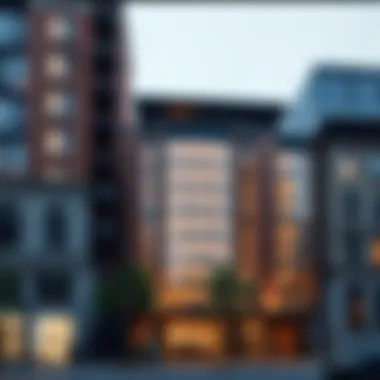
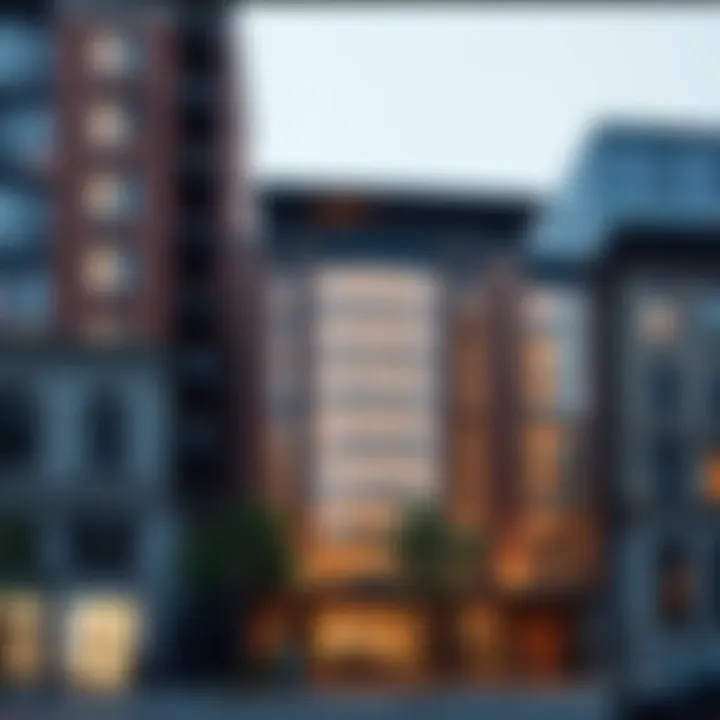
Community Features
The Al Ward Building is not just a place to lay your head; it's a community where connections flourish. One of the most appealing aspects here is the range of communal amenities designed to enhance the living experience. Picture a well-maintained swimming pool on a hot Dubai day, offering a refreshing escape right at your doorstep.
In addition to recreational facilities, the building often features landscaped gardens and walking paths, promoting a lifestyle that values both tranquility and activity. For families, the presence of children's play areas cannot be overstated. A safe, engaging space makes a significant difference, allowing parents peace of mind while their kids explore and play.
Furthermore, the Al Ward Building fosters a sense of belonging among its residents. Host community events and gatherings nurture relationships and create a friendly atmosphere. This sociability can be particularly important for expatriates navigating a new city. When it comes to community life, the building stands out as a hub of social interaction, allowing residents to mingle and share experiences.
Lifestyle Factors
Life at the Al Ward Building is characterized by a lifestyle that balances convenience and leisure. Its strategic location grants residents easy access to a plethora of essential services such as supermarkets, pharmacies, and educational institutions, all just a stone's throw away. For instance, having a grocery store within walking distance can save time and energy, particularly for those with busy work schedules.
Moreover, residents are often drawn to the vibrant culinary scene nearby. A variety of restaurants, cafes, and eateries offer a plethora of dining options, ranging from local flavor to international cuisine. This accessibility not only enriches daily life but also fosters a sense of indulgence that is hard to overlook. Want to unwind after a long day? Numerous coffee shops beckon for a cozy evening out.
For fitness enthusiasts, many properties, including the Al Ward Building, provide gym facilities equipped with modern equipment. This fosters an active lifestyle, encouraging residents to prioritize their health without the hassle of traveling far. Whether it's an early morning jog in the park or an evening swim, options abound for maintaining a healthy routine.
In sum, living at the Al Ward Building means embracing a lifestyle that is vibrant and inclusive, with each feature thoughtfully designed to cater to the diverse needs of those who call it home.
Regulatory Considerations
Understanding the regulatory framework surrounding property ownership in Dubai is essential for anyone eyeing the Al Ward Building as an investment or residence. Regulatory considerations not only shape market dynamics but also influence the decisions of investors and homebuyers. Familiarizing oneself with these laws ensures compliance and can significantly enhance the overall investment experience.
Property Ownership Laws
In Dubai, property ownership laws are primarily governed by the Real Estate Regulatory Agency (RERA). This body ensures that all real estate transactions are conducted transparently and fairly, providing a legal foundation for both residents and expatriates.
- Freehold vs. Leasehold: In Dubai, property can be owned either as freehold or leasehold. Freehold ownership, allowing full control and rights over the property, is available in designated zones. On the other hand, leasehold agreements typically run for 99 years, requiring the lessee to return the property to the lessor once the lease expires.
- Ownership for Non-Residents: Expatriates can purchase properties in specific areas marked for foreign ownership. This is particularly appealing given that non-residents make up a sizable portion of Dubai's real estate market. Key areas include Dubai Marina and Downtown Dubai.
- Registration and Fees: A significant aspect of property ownership also revolves around the registration process. Buyers must register their property with the Dubai Land Department, paying a fee that often reaches 4% of the property's value. This registration solidifies ownership rights and serves as an important legal safeguard.
Additionally, every landlord has responsibilities towards the tenants, which are outlined in both tenancy contracts and local laws.
Key Regulations Affecting Investors
Investors need to keep their ears to the ground when it comes to regulations that can shift the market landscape. Some of the pertinent regulations include:
- Investor Visa Regulations: Owning property valued at AED 1 million or more can grant one a residency visa, a crucial incentive attracting foreign buyers. This underscores the government’s commitment to enhancing its property market’s appeal.
- Tax Implications: Unlike many countries, Dubai does not impose an annual property tax, incentivizing investors to consider long-term real estate engagements. However, it’s important to note that there might be fees related to property management and maintenance, which should be budgeted accordingly.
- Title Deeds: Investors must secure a title deed to assert ownership, and these deeds are released after the registration process is completed. This deed is vital as it serves as proof of ownership, indicating the property’s legal status.
- Sustainability Regulations: With Dubai’s push for sustainability, properties are increasingly assessed based on energy efficiency and sustainability features. Such regulations not only promote a greener environment but also boost the property’s market value in the long run.
Understanding the legal framework can be the difference between a rewarding investment and potential pitfalls.
In summary, navigating the regulatory landscape of the Al Ward Building and its investment potential is not just about understanding ownership laws, but also about grasping the broader regulatory environment. Investors must remain informed and agile to maximize their opportunities while mitigating risks.
A deeper grasp of these regulations may also foster confidence among buyers, enabling them to make informed decisions as they explore all that Dubai’s vibrant property market has to offer.
Epilogue
In wrapping up our discussion on the Al Ward Building, it’s crucial to distill the key elements that emergeth as significant not just for understanding the building itself but also for gauging its impact in the broader context of Dubai's dynamic real estate landscape.
Firstly, the architectural design and features of the Al Ward Building exemplify modernity with a nod to sustainability. This attention to eco-friendly practices elevates its appeal, resonating with today’s conscious investors and homebuyers. Given the historical trend towards more sustainable real estate options, this building positions itself strategically within a marketplace that's increasingly valuing environmental stewardship.
Moreover, the location plays an instrumental role. Nestled in a vibrant area known for its accessibility and amenities, the building boasts proximity to essential services, leisure activities, and key business districts. This not only enhances the living experience but also augments the property's potential allure to future buyers or renters.
When we dive into investment prospects, the analysis shows promising trends. With increasing demand in Dubai's real estate sector, opportunities abound for those looking to invest. To navigate this landscape effectively, understanding current market dynamics and future predictions is paramount. For instance, shifts in buyer preferences towards properties boasting luxury finishes and communal spaces increase the odds favoring buildings like Al Ward to attract discerning clientele.
Socioeconomic factors also bear repeating in this conclusion. The bustling multicultural environment of Dubai, enriched by expatriate populations, demonstrates sustained demand for housing. For investors and developers, this creates an ecosystem ripe for engagement and growth.
In summary, the Al Ward Building emerges not merely as a structure but as a paradigm of what modern living in Dubai represents. Its thoughtful integration of design, location advantages, and investment viability creates a compelling narrative. For homebuyers, investors, and real estate professionals alike, it serves as a landmark in Dubai's ongoing story of growth and transformation.
"The Al Ward Building is more than just bricks and mortar; it's a symbol of opportunity within a thriving market."
For further information and real estate insights, visit reputable resources like Wikipedia or Britannica. Engaging in forums at Reddit can also provide valuable perspectives on real estate trends in Dubai.
Importance of Properly Citing Sources
When discussing architectural significance, location benefits, or investment risks, references lend authority to the article. By citing reputable sources, such as government reports, university studies, and industry analysis, the article gains the trust of its audience. Investors and homebuyers often depend on well-supported information to make informed decisions. Thus, outlining the sources helps substantiate claims regarding the Al Ward Building's capabilities and potential in the market.
"An informed decision today lays the foundation for tomorrow’s success in real estate investment."
Resources to Explore
Accurate references can further open the door to a wealth of knowledge. The following resources can be invaluable for readers who seek to delve deeper into the surrounding context of the Dubai real estate market:
- Dubai Land Department: Government insights into property ownership and market trends.
- UAE Federal Competitiveness and Statistics Authority: Valuable statistics and demographic data relevant to real estate.
- Wikipedia on Real Estate in Dubai: A historical and cultural overview of Dubai’s property landscape.
- Reddit’s Real Estate Community: Real-life experiences and discussions regarding property investments.
Considerations and Benefits
For homebuyers and investors alike, the availability of references leads to better-informed decisions. Readers can cross-check facts, understand varied viewpoints, and explore additional qualitative data about the Al Ward Building or the market at large. This understanding not only enriches the reading experience but also cements the position of the Al Ward Building as a compelling option for housing or investing in Dubai.



